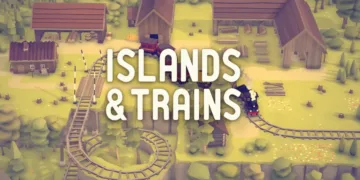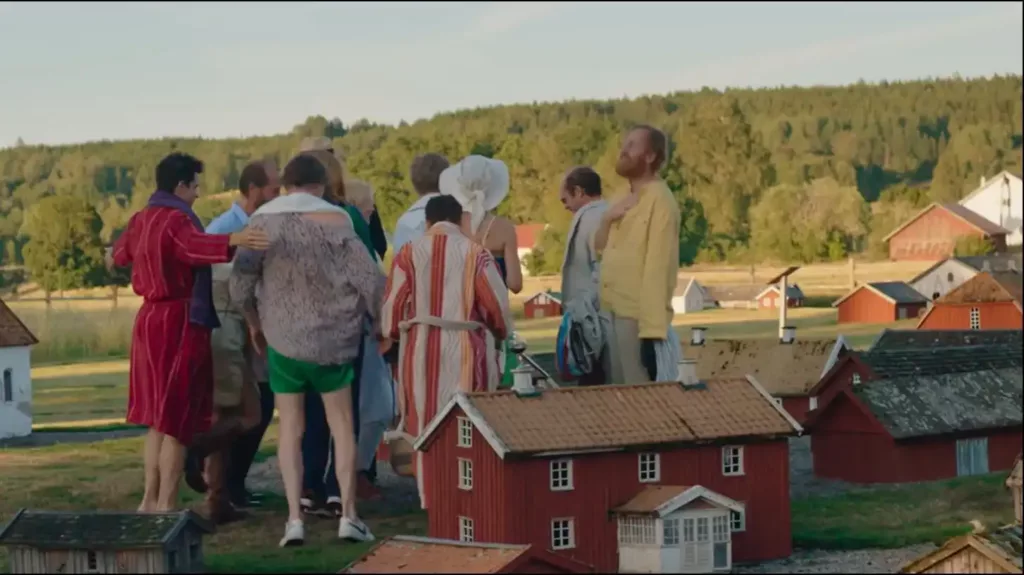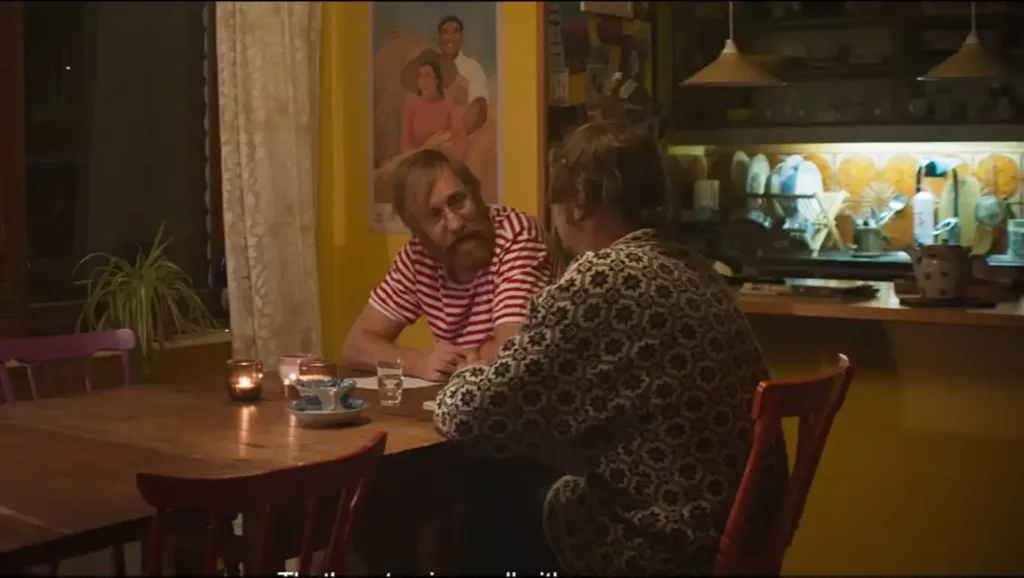It’s been over two decades since viewers were first introduced to the commune members at the heart of Lukas Moodysson’s 2000 Swedish film Together. Set in 1975, the comedy follows a group of youths living an alternative lifestyle in Stockholm as they embrace free love, protest the establishment, and cook endless pots of chickpeas. While poking gentle fun at their eccentric habits and utopian ideals, it did so with such good humor and charm that audiences connected deeply with this band of loving, if flawed, individuals.
Now writer-director Moodysson has reassembled much of the original cast to check in on what’s become of these free spirits after another 24 years have passed. In Together 99, we find that Göran and Klasse are the only two remaining residents of the commune, which they now refer to more as a home than a collective. To celebrate Göran’s birthday, Klasse organizes a surprise reunion, bringing the past inhabitants back together under one roof. Though nostalgia abounds as old friends swap stories and memories from their younger days, cracks also emerge in carefully reconstructed versions of the past, and divisions are revealed in how their ideals evolved.
While recapturing some of the warmth and wit of its predecessor, Together 99 takes a slightly darker look at what happens when counterculture ambitions meet middle age. Idealism has given way to disillusionment for many, though Moodysson locates moments of perseverance amongst the dissolutions. An affecting reflection on the challenges of aging and how generations build upon each other, it proves an engaging companion piece nearly a quarter century later while subtly considering the themes that first endeared us to this community.
Reconnecting After Time Apart
It’s been over two decades since the inhabitants of the commune first shared their lives together on screen. Now only two remain living as roommates in the spacious home: Göran and Klasse. Though they still call themselves a commune, their alternative lifestyle exists in a thinner form. Göran contributes political articles, while Klasse weaves colorfully patterned rugs.
Seeking to lift the spirits of his longtime companion, Klasse decides to gather their former brothers and sisters in radical thought to celebrate Göran’s upcoming birthday. He sends invitations, reuniting the scattered members, hoping nostalgia for past camaraderie might briefly fill the hollow left by time’s erosion of their youthful convictions. On the appointed afternoon, unfamiliar faces from years past ventured to the house, gifts and happy memories in hand.
But not all traces of the past have faded so smoothly. Old tensions and competing visions surface as drinks flow freely. Erik engages in heated disputation over economics, as was his style, but finds less interest this time. Anna’s courteous responses to topics of romance strained. And Lena arrives with a sullen teenager in tow, stirring perplexing questions about parentage and her own mental well-being.
As night descends, carefully reconstructed versions of shared histories break apart, revealing changed priorities and disconnected paths. Though longing for the solidarity that first drew them together, it becomes clear that for this group of aging activists, ideals could not be sustained in the same form against life’s persistent tides of compromise and loss.
Returning to Roots
For Göran and Klasse, clinging to the commune remains a steadfast pursuit despite being the sole survivors of that close-knit community. Where others sought careers and social status, the pair continued crafting political tracts and artisanal rugs within the walls that harbored their radical ideals. Yet even for these holdouts, nostalgia for what clearly spurred the birthday gathering is a longing to reconnect fractured links from the past.
Most former inhabitants now exemplify routes less bohemian. Successful professionally and well-heeled financially, some contradict the principles defining life at the commune. The very couple ousted for television ownership presently work within its industry. And vocal feminist Anna adopts conventional norms like hair removal, distanced from her unabashed younger self.
Only Erik retains unbridled zeal for socialist politics, albeit redirected towards more conservative aims these days. For him and others facing their 50s, youthful fervor cooled recognizably as pragmatic realities set in. Gone is the blithe optimism that propelled communal dreams, replaced by a wearier acknowledgment of compromises made.
Subtler shifts also emerge. Lena arrives enveloped in mystery, her mental state cleaved from the carefree girl of before. And tensions linger beneath cordiality’s surface between Anna and creative partner Lasse, now coupled to a new flame.
As members reassemble across the chasms of a quarter century, their gathering glimpses how completely the tides of living dismantled utopian plans. Yet for Göran and Klasse alone, the evening also reaffirms that those roots remain a source of inherent purpose and belonging, however diminished in form.
Nostalgia and What Remains
As the friends reunite decades later, certain themes emerge regarding their journey from youthful dreams. Chief among them was how completely the tides of living dismantled utopian plans forged within those walls. What was once a commune bound by shared beliefs has long dissolved, its remnants floating free on diverging currents.
Only Göran and Klasse withstand that pull solely, persisting in habits now more custom than cause. For others, careers and social roles took root where radicalism once flourished. Some contradict ideals blithely spoken of before. The principled TV ban now guides broadcasts, with activism mellowed by bourgeois comforts.
More subtly, disillusion haunts spaces that optimism cannot reclaim. Gone is enthusiasm for changing the world; sobered understanding takes its place. Aging challenges former declarations of free love, while the distance grown between youthful selves and their modern parallels speaks volumes.
Loneliness edges bitter where solace was sought, revealed in the mystery shrouding one and misery another brings. Mental turmoil remains as sensitively handled now as ideals prove fleeting against life’s tides.
Nostalgia itself emerges as a theme, a bittersweet balm revisiting what could never last. Fondness flows freely as wine, yet shadows lurk beneath surfaced memories. Hopes birthed anew come hardened too; generational divides become clearer in conflicting views of days depicted as rosy through the lens of time.
Still, glimpses of that camaraderie’s power appear, proving some things withstand dissolution. In shared reminiscence and fragile fellowship rebuilt, wistfulness finds solace for what remains when youth and its careless declarations fade into the night.
Reflecting Lives Through the Lens
While Together 99 brings together laughs and lamentations, Lukas Moodysson’s approach ensures neither overwhelms. His signature roving camera follows the crew through Klasse’s home as conversation flows freely, ebbing and rising like a gentle tide. Details emerge, not forced but found, small tales unveiling larger truths underneath surface remarks.
Moments leave indelible marks just seen from the corners, fleeting glimpses capturing diverse dimensions. Laughter becomes lore when one recalls the fungal friend of days past; smiles soften as sorrows surface too. Figures left in shadows slowly step to light through a listening lens, letting lives unfold at their own pace.
Subtleties stand out where superficial scripts may smooth over. Successes and struggles receive equal regard and weight. No character bears judgment; all are granted complexity, mingling mirth and melancholy. Meaning manifests in minutiae, meaningful observations blossoming between beats of exchange and age.
Seamlessly do grins morph to grimaces and back again, whimsy wavering into wisdom. Lightness lifts drear themes just as ironic quips stir reflection. Never does one sense the director delighting in details, dining on divergences that spread across a spectrum.
Through wandering windows into intimate worlds, Moodysson masters melding modes to mirror the whole. Laughter and lamentation, failure found alongside fondness—pieces fit together of lives in transition, in observation.
Reflections of Times Past
Watching Together 99, it’s easy to see parallels to movies like The Big Chill, where communities that challenged the status quo reunite years later as things have changed. But Moodysson puts his own spin on this genre.
While other films focus on former activists grappling with careers and families, Together 99 delves deeper. It shows how whole generations can shift focus, for better or worse. The ideals that drove the commune have faded, leaving solace where fervor once ruled.
Yet glimpses remain of passions past. In disputing the cruelty of “Pippi Longstocking’s” ways, Erik proves some flames are still flickering, though less compel others now. Through its wit and wistful tones, the film reflects on how shared drives divide over time through life’s own tides.
Its messages resonate too, in eras where crises prompt little action. The characters’ indifference to troubles plaguing the world mirrors their lateness today regarding problems demanding remedies.
By turn funny and melancholic, Moodysson offers astute commentary on change within communities and between generations. His unique treatment reminds me that there’s value in looking back, to weigh dreams against realities, and to find threads linking yesterday to today. Sometimes the best we can do is appreciate what remains and each other.
Reflections of Times Past and People
Together 99 reveals much about its characters facing failures and changes over the decades. While some embraced new lives, others, like Göran and Klass, kept the commune’s spirit alive despite hardships.
The film shows both the sour notes life played for these freethinkers and their perseverance in community. Even through disagreements and hard truths, bonds endured between this unconventional family. Both the joy and disillusionment of their past experiences resonate in quieter moments together.
For all its raw looks at struggles within and without, Moodysson’s work pays fitting homage to dreamers of another era. It captures the bittersweetness of revisiting what was and what became of those who took different paths. Though imperfect, Together 99 offers an authentic glimpse into lives marching to their own beat amid the alterations of time.
Fans of the original will find this sequel an insightful companion piece. But even those simply curious about countercultures past will find thoughtful portrayals of grassroots idealism gently sprouting even in rocky soil. For its empathic lens on the resilience of the spirit amid changing tides, Moodysson’s movie deserves appreciation.
The Review
Together 99
While not perfectly executed, Together 99 offers an affecting glimpse into lives transformed by the years yet still connected by shared history. Moodysson presents the commune's decline and its members' diverging ideals with empathy and humor. Despite some shortcomings, the film ultimately succeeds in its aim to pay tribute to the enduring spirit of its characters and the era they represented.
PROS
- Authentic portrayal of characters and how they've changed over time
- Thoughtful exploration of counterculture ideals and what remains
- Observant direction that draws out nuanced performances
- Empathetic lens on persevering community despite hardships
CONS
- The plot is somewhat predictable and lackluster at times
- Humor and heartfelt moments are less pronounced than original
- Characters aren't as distinctly memorable or dynamic as before
- Politics and themes feel rushed and not fully realized






















































Discussion about this post